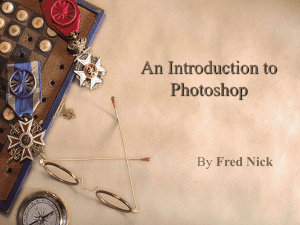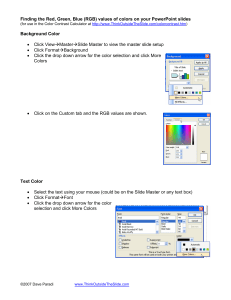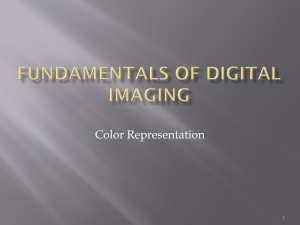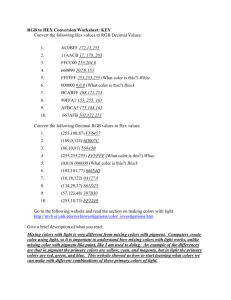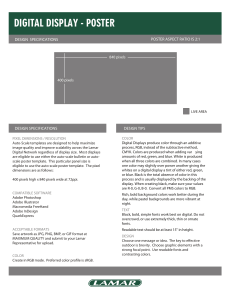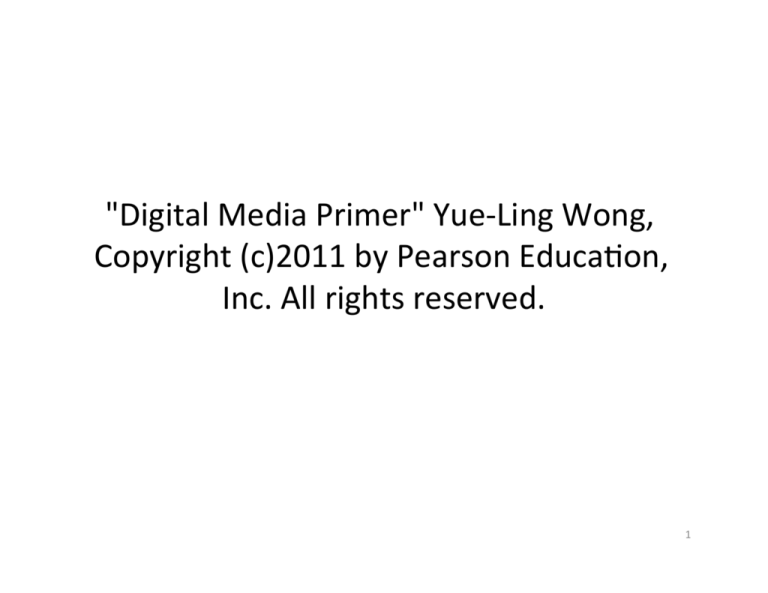
"Digital Media Primer" Yue-­‐Ling Wong, Copyright (c)2011 by Pearson EducaDon, Inc. All rights reserved. 1 Chapter 2 Fundamentals of Digital Imaging Part 4 Color RepresentaDon 2 In this lecture, you will find answers to these quesDons • What is RGB color model and how does it represent colors? • What is CMY color model and how does it represent colors? • What is HSB color model and how does it represent colors? • What is color gamut? What does out-­‐of-­‐gamut mean? • Why can't the colors on a printout match exactly what you see on screen? 3 Color Models • Used to describe colors numerically, usually in terms of varying amounts of primary colors. • Common color models: – RGB – CMYK – HSB – CIE and their variants. 4 RGB Color Model • Primary colors: – red – green – blue • AddiDve Color System 5 AddiDve Color System 6 AddiDve Color System of RGB • Full intensiDes of red + green + blue = white • Full intensiDes of red + green = yellow • Full intensiDes of green + blue = cyan • Full intensiDes of red + blue = magenta • Zero intensiDes of red, green, and blue = black • Same intensiDes of red, green, and blue = some kind of gray 7 Color Monitors From a standard CRT monitor screen
8 Color Monitors From a SONY Trinitron monitor screen
9 Color Monitors From a LCD screen
10 RGB Color Model • depicted graphically as a cube defined by three axes in 3-­‐D space • The maximum value on eachaxis is normalized to 1. 11 RGB Color Model • x-­‐axis: red values • y-­‐axis: green values • z-­‐axis: blue values 12 RGB Color Model • The coordinates within the color cube represent the relaDve intensiDes of red, green, and blue colors. 13 RGB Color Model • origin (0,0,0): black 14 RGB Color Model • (1,0,0): full intensity of red 15 RGB Color Model • (0,1,0): full intensity of green 16 RGB Color Model • (0,0,1): full intensity of blue 17 RGB Color Model • (1,1,1): white 18 RGB Color Model • (1,1,0): full red + full green = full yellow 19 RGB Color Model • (1,0,1): full red + full blue = full magenta 20 RGB Color Model • (0,1,1): full green+ full blue = full cyan 21 Color Picker So where is the color whose RGB values are (150, 200, 100) in the RGB cube?
22 CorrelaDng RGB Color Cube with Color Picker This is a 2-D slice containing all the colors with red = 150.
23 CorrelaDng RGB Color Cube with Color Picker This is a 2-D slice containing all the colors with green = 200.
24 CorrelaDng RGB Color Cube with Color Picker This is a 2-D slice containing all the colors with blue = 100.
25 CorrelaDng RGB Color Cube with Color Picker The color (150, 200, 100) is located in the 3-D space of the RGB color cube.
It is at the intersection of the three 2-D slices.
26 CMYK Color Model • Primary colors: – cyan – magenta – yellow – black • SubtracDve Color System 27 SubtracDve Color System of CMY 28 SubtracDve Color System of CMY • Full intensiDes of cyan + magenta + yellow = black (theoreDcally, but in pracDce with inks, it is not full black) • Full intensiDes of cyan + magenta = blue • Full intensiDes of cyan + yellow = green • Full intensiDes of magenta + yellow = red • Zero intensiDes of cyan, magenta, and yellow = white 29 HSB Color Model • Hue: – basic color – 0o to 360o : the locaDon on a color wheel – in the order of colors in a rainbow • SaturaDon: – purity of the color – how far away from the neutral gray of the same brightness • Brightness 30 HSB Color Model 31 HSB Color Model 32 HSB Color Model A slice of the color wheel from the HSB model
33 HSB Color Model • Matches well with the way humans intuiDvely think about colors • For example, how would you describe this color? • Would you think of it in terms of how much red, green, and blue? • Would you first think of it as a yellowish color and then figure out the lightness and how washed out the color is? 34 Problems with RGB and CMYK Color Space • Do not encompass all the colors human can see 35 CIE XYZ Color Model • Primaries: – X – Y – Z • Primaries are not physical colors • Its color space encompasses all the colors human can see. • Normally not used in digital image ediDng because monitors and printers cannot reproduce all the colors in the CIE XYZ color space anyway. 36 Color Gamuts • Refers to the range of colors of a specific system or device can produce or capture 37 Color Gamuts a) Colors that human can see b) RGB color gamut of typical CRT monitors c) CMYK color gamut of typical inkjet printers 38 Color Gamuts •
•
Monitors and inkjet printers cannot reproduce all the colors that human can see Some of the colors that monitors can reproduce cannot be reproduced by inkjet printers. Most of these colors lie at the corners of the color gamut of the monitor, which means these are highly saturated colors. 39 IdenDfying Out-­‐of-­‐Gamut Colors in Images • Out-­‐of-­‐gamut colors will not be printed correctly. • In digital image ediDng programs such as Adobe Photoshop, you can tell whether a color is out of gamut based on your CMYK sejng. • Click on the icon to use the closest color in gamut for prinDng. 40 IdenDfying Out-­‐of-­‐Gamut Colors in Images • Out-­‐of-­‐gamut colors will not be printed correctly. • In digital image ediDng programs such as Adobe Photoshop, you can tell whether a color is out of gamut based on your CMYK sejng. 41 IdenDfying Out-­‐of-­‐Gamut Colors in Images 42 IdenDfying Out-­‐of-­‐Gamut Colors in Images Click on the icon to replace the out-of-gamut color with the closest
color in gamut for printing.
43 IdenDfying Out-­‐of-­‐Gamut Colors in Images The out-of-gamut color is replaced with the closest color in gamut for
printing.
44 DifficulDes in Reproducing Colors in Digital Images • Digital devices cannot produce all of the colors visible to human • DifficulDes exist in reproducing color across devices – different devices have different color gamuts – addiDve color system for screen display vs. subtracDve color system for prinDng 45 Indexed Color 46 Indexed Color 47 Review QuesDons Note to instructor: Depending on your preference, you may want to go over the review quesDons at the end of this lecture as an instant review or at the beginning of next lecture to refresh students' memory of this lecture. 48 Review QuesDon What are the primary colors in the RGB color model? 49 Review QuesDon What are the primary colors in the CMY color model? 50 Review QuesDon What are the primaries in the HSB color model? 51 Review QuesDon Which of the following color models take(s) the form of a color cube? A. RGB B. CMY C. HSB D. CIE XYZ 52 Review QuesDon Which of the following color models take(s) the form of a hexacone? A. RGB B. CMY C. HSB D. CIE XYZ 53 Review QuesDon Which of the primaries in the HSB color model takes the form of a color wheel? A. Hue B. SaturaDon C. Brightness 54 Review QuesDon What is the color mixing method for the RGB color model? A. addiDve B. subtracDve 55 Review QuesDon What is the color mixing method for the CMY color model? A. addiDve B. subtracDve 56 Review QuesDon What are the RGB values for white? What are the CMY values for white? 57 Review QuesDon What are the RGB values for black? What are the CMY values for black? 58 Review QuesDon What are the RGB values for red? What are the CMY values for red? 59 Review QuesDon What are the RGB values for green? What are the CMY values for green? 60 Review QuesDon What are the RGB values for blue? What are the CMY values for blue? 61 Review QuesDon What are the RGB values for yellow? What are the CMY values for yellow? 62 Review QuesDon Why don't the colors in the printed image look exactly the same as you see on screen? 63

